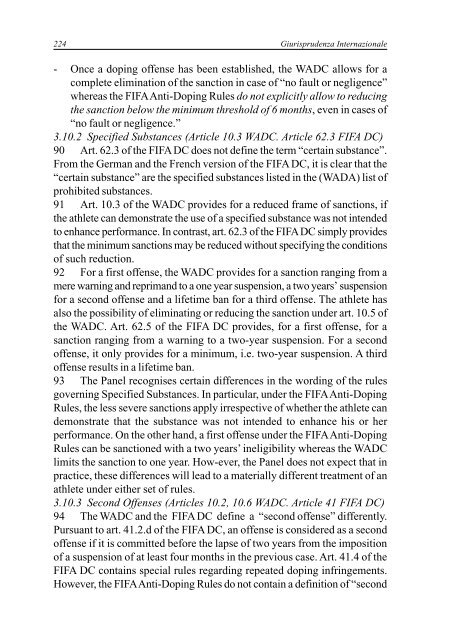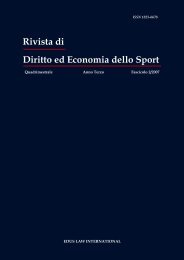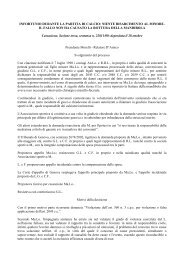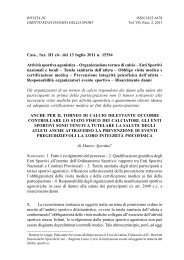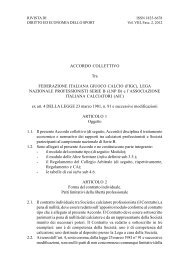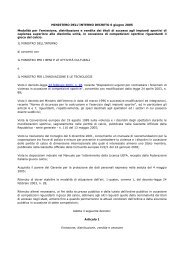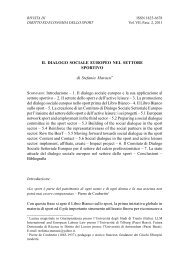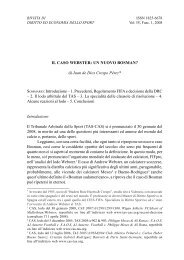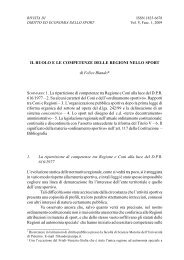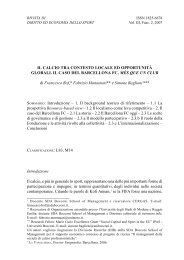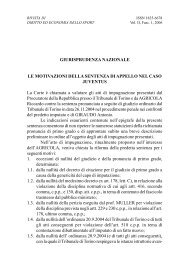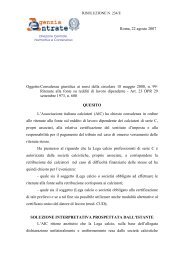Rivista di Diritto ed Economia dello Sport - Rdes.it
Rivista di Diritto ed Economia dello Sport - Rdes.it
Rivista di Diritto ed Economia dello Sport - Rdes.it
Create successful ePaper yourself
Turn your PDF publications into a flip-book with our unique Google optimized e-Paper software.
224 Giurisprudenza Internazionale- Once a doping offense has been establish<strong>ed</strong>, the WADC allows for acomplete elimination of the sanction in case of “no fault or negligence”whereas the FIFA Anti-Doping Rules do not explic<strong>it</strong>ly allow to r<strong>ed</strong>ucingthe sanction below the minimum threshold of 6 months, even in cases of“no fault or negligence.”3.10.2 Specifi<strong>ed</strong> Substances (Article 10.3 WADC. Article 62.3 FIFA DC)90 Art. 62.3 of the FIFA DC does not define the term “certain substance”.From the German and the French version of the FIFA DC, <strong>it</strong> is clear that the“certain substance” are the specifi<strong>ed</strong> substances list<strong>ed</strong> in the (WADA) list ofprohib<strong>it</strong><strong>ed</strong> substances.91 Art. 10.3 of the WADC provides for a r<strong>ed</strong>uc<strong>ed</strong> frame of sanctions, ifthe athlete can demonstrate the use of a specifi<strong>ed</strong> substance was not intend<strong>ed</strong>to enhance performance. In contrast, art. 62.3 of the FIFA DC simply providesthat the minimum sanctions may be r<strong>ed</strong>uc<strong>ed</strong> w<strong>it</strong>hout specifying the con<strong>di</strong>tionsof such r<strong>ed</strong>uction.92 For a first offense, the WADC provides for a sanction ranging from amere warning and reprimand to a one year suspension, a two years’ suspensionfor a second offense and a lifetime ban for a third offense. The athlete hasalso the possibil<strong>it</strong>y of eliminating or r<strong>ed</strong>ucing the sanction under art. 10.5 ofthe WADC. Art. 62.5 of the FIFA DC provides, for a first offense, for asanction ranging from a warning to a two-year suspension. For a secondoffense, <strong>it</strong> only provides for a minimum, i.e. two-year suspension. A thirdoffense results in a lifetime ban.93 The Panel recognises certain <strong>di</strong>fferences in the wor<strong>di</strong>ng of the rulesgoverning Specifi<strong>ed</strong> Substances. In particular, under the FIFA Anti-DopingRules, the less severe sanctions apply irrespective of whether the athlete candemonstrate that the substance was not intend<strong>ed</strong> to enhance his or herperformance. On the other hand, a first offense under the FIFA Anti-DopingRules can be sanction<strong>ed</strong> w<strong>it</strong>h a two years’ ineligibil<strong>it</strong>y whereas the WADClim<strong>it</strong>s the sanction to one year. How-ever, the Panel does not expect that inpractice, these <strong>di</strong>fferences will lead to a materially <strong>di</strong>fferent treatment of anathlete under e<strong>it</strong>her set of rules.3.10.3 Second Offenses (Articles 10.2, 10.6 WADC. Article 41 FIFA DC)94 The WADC and the FIFA DC define a “second offense” <strong>di</strong>fferently.Pursuant to art. 41.2.d of the FIFA DC, an offense is consider<strong>ed</strong> as a secondoffense if <strong>it</strong> is comm<strong>it</strong>t<strong>ed</strong> before the lapse of two years from the impos<strong>it</strong>ionof a suspension of at least four months in the previous case. Art. 41.4 of theFIFA DC contains special rules regar<strong>di</strong>ng repeat<strong>ed</strong> doping infringements.However, the FIFA Anti-Doping Rules do not contain a defin<strong>it</strong>ion of “second


